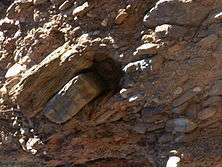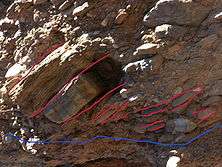Imbrication (sedimentology)
In sedimentology imbrication refers to a primary depositional fabric consisting of a preferred orientation of clasts such that they overlap one another in a consistent fashion, rather like a run of toppled dominoes. Imbrication is observed in conglomerates and some volcaniclastic deposits.[1][2]

Imbricated clasts, with an implied flow direction of left to right.

Note how the clasts are oriented at an angle to the base of the channel (blue line), which was originally approximately horizontal.
Types
- In conglomerates the shape of many clasts can be approximated to an ellipsoid, with a long axis (A), an intermediate axis (B) and a short axis (C).
- A-axis imbrication where the long axes of the clasts are oriented parallel to the flow direction. This fabric is characteristic of clasts carried in suspension and this is only preserved in the case of a fast-waning flow in which the clasts are deposited without any significant rolling. This fabric is typical of conglomerates at the base of turbidite beds but is also occasionally observed in alluvial fan deposits reworked by flash floods [3]
- AB-plane imbrication where the long axes of the clasts are oriented perpendicular to the flow direction and the imbrication is of the flattened AB plane, with the intermediate axes in the flow direction. This fabric is characteristic of clasts carried as bedload. This imbrication forms as the clasts are rolled along the base of a channel. The flat clasts roll onto those downstream and come to rest with their downstream end propped up by the downstream pebbles and can be used to diagnose original flow directions.
Relation to paleocurrent
The type of imbrication is generally related to paleoflow direction.[4] Wadell[5] found the long axis aligned with paleocurrent, and dipping basinward in glacial sediments, whereas deltaic gravels may be oppositely inclined.[6]
gollark: I read Gaiman's *Norse Mythology* and quite liked it, but I also don't actually think it's *true* and wouldn't want to live in a Norse-mythology-driven world anyway.
gollark: Can gods communicate via LEDish "candles" instead of flamey ones? It seems a bit of a fire risk.
gollark: You should join my religion. We have a 30 days satisfaction or your belief back guarantee, and you can keep your existing religion.
gollark: I just ignore that sort of thing, for purposes.
gollark: Coolness, aesthetic sensibility, alignment with my ethical values, etc.
References
- Karatson,D., Sztano,O. & Telbisz,T. (2002). "Preferred Clast Orientation In Volcaniclastic Mass-Flow Deposits: Application Of A New Photo-Statistical Method" (PDF). Journal of Sedimentary Research. 72 (6): 823. Bibcode:2002JSedR..72..823K. doi:10.1306/040402720823. Archived from the original (PDF) on 2009-11-16.CS1 maint: multiple names: authors list (link)
- Pettijohn F. J., 1957, Sedimentary Rocks, Harper and Row, Second Edition p. 78
- Sinclair,H.D. & Jaffey,N. 2001 (2001). "Sedimentology of the Indus group, Ladakh, northern India: Implications for the timing of initiation of the palaeo-Indus River". Journal of the Geological Society. 158: 151–162. doi:10.1144/jgs.158.1.151.CS1 maint: multiple names: authors list (link)
- Becker G.F. (1893). "Finite homogenous strain, flow, and rupture of rock". Bull. Geol. Soc. Am. 4: 13–90. Bibcode:1892GSAB....4...13B. doi:10.1130/gsab-4-13. hdl:2027/mdp.39015066907851.; cite in Pettijohn, 1957.
- Wadell, H., 1936, Shape and position of rock fragments, Geografiska Annaler, pp. 74-92, cite in Pettijohn, 1957.
- Krumbein W. C. (1940). "Flood gravel of San Gabriel Canyon". Bull. Geol. Soc. Am. 51: 636–676.
External links
This article is issued from Wikipedia. The text is licensed under Creative Commons - Attribution - Sharealike. Additional terms may apply for the media files.